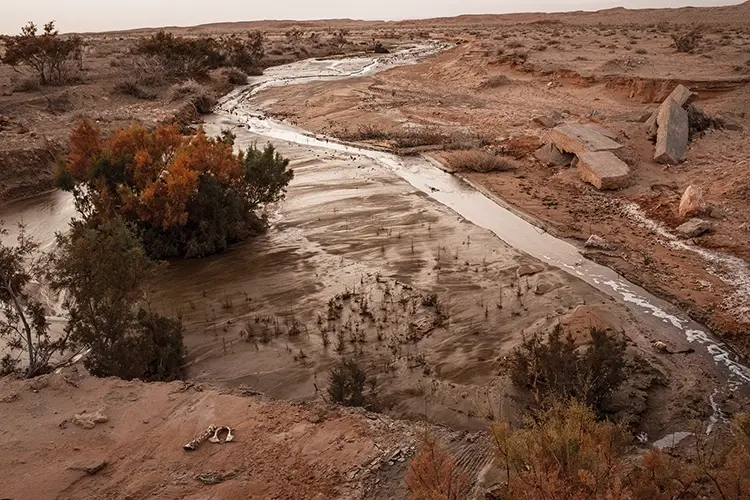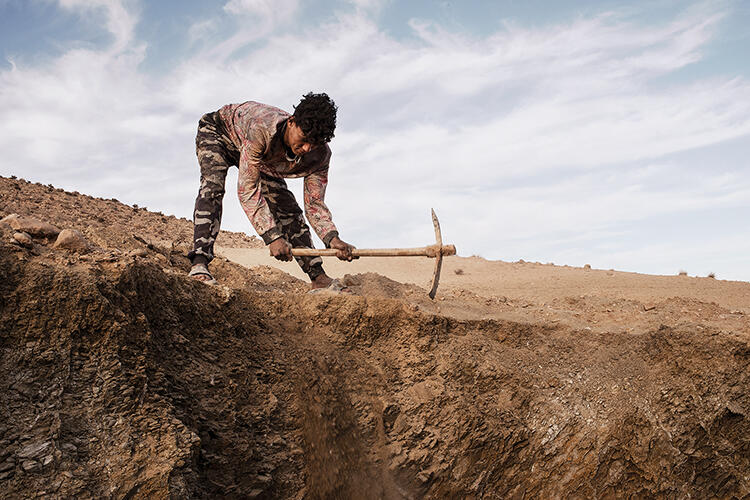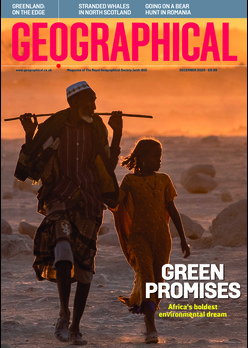
The Gafsa Valley is home to the world’s fourth-largest phosphate reserve. However, its extraction is turning the once-fertile land into a polluted desert
By Arianna Poletti and Sofian Philip Naceur , photographs by Daniela Sala
During the harvest season, Mahmoud Snaidiya’s olive and pistachio fields are a hive of activity. Hens and geese roam freely while his family gathers in the shade of trees in the Dwara, one of the last agricultural enclaves in the Gafsa mining valley, near Tunisia’s southern border with Algeria.
Once, this was an area dominated by collective farming. Today, however, the few remaining farmers are struggling to keep going. ‘Rainfall is decreasing and groundwater is expensive’, Mahmoud explains. ‘One hour of water from the agricultural consortium’s well costs us six dinars [£1.50]. Each year, the harvest gets worse.’

Mahmoud clings to his unproductive land. It was his family’s escape from the phosphate mining that dominates the valley. His father worked underground in the mines in the nearby town of Moularès until the dirt and pollution got too much for the family.
The sad irony is that the industry’s insatiable demand for water needed to process the phosphate rock into fertiliser for the world’s agriculture is the reason Mahmoud’s farm is now struggling to survive. Moularès embodies the history of a valley reshaped by global fertiliser production and the extraction of the mineral that drives it – phosphate.
Phosphate rocks are essential for producing phosphorus fertilisers, one of intensive agriculture’s most widely used chemicals. It’s only found in a few countries and the Gafsa Valley holds the world’s fourth-largest phosphate reserve. This dark powder, processed into white pellets and transported from Tunisia around the world, has transformed this valley, 400 kilometres south of Tunis.

The growing climate crisis has amplified the severe environmental and human consequences the industry has already inflicted on the region. While Tunisian phosphorus feeds Western fields, phosphate extraction is drying out the land of Gafsa’s local communities.
‘If we could access all the water these mountains hold, we would be the top agricultural region in the country,’ Taoufik Ain exclaims, sitting under Mohamed’s olive tree. The Dwara region is a lush patch of green surrounded by ochre-coloured expanses where herds of camels graze the rare desert vegetation.
Large amounts of groundwater are used to purify the ore in water basins built in the centre of the Gafsa Valley’s mining towns. According to the Tunisian Water Observatory, a Tunisian civil society association that monitors water management and droughts, 1.5 cubic metres of water are required to produce one tonne of phosphate.

‘This extensive use of water for washing impurities from phosphate rocks has drastically reduced the water available for local agriculture,’ explains Taoufik Ain, a member of the Network for Transparency in the Energy and Mining Industry.
A prominent figure in the civil society of the mining basin, Taoufik Ain was Mahmoud’s teacher at the Moularès workers’ school. He educated a generation of miners’ children who, like their parents, hoped to join the ‘Cherika’, which in Arabic means ‘company.’ The Gafsa Phosphate Company (CPG) is the only major employer in the region.
Many of the region’s youth were hired by a company affiliated with the CPG, the Environmental Company of Gafsa, founded by Tunisia’s president Zine El Adidine Ben Ali in 2008 during protests by young unemployed workers. Ben Ali was deposed during the Arab Spring in 2011 and fled to Saudi Arabia.
‘The former dictator bought social peace by giving our sons fictitious jobs,’ explains Ain. His former student Mohamed is one of them; he is now turning to farming to fill his empty days and earn a bit more.
‘But the CPG, a state within the state in the Gafsa region, now is taking our water too,’ Ain complains.

‘During the 1990s, the price of phosphates increased, prompting us to maximise production,’ explains one of the engineers from the Gafsa Phosphate Company (CPG), speaking anonymously. ‘The unique feature of the region is that the phosphate layers are shallow and horizontal. Since then, we have used dynamite to extract a larger quantity of the mineral, rather than searching for it underground, which then needs to be purified with water and chemicals.’
Established in the Gafsa region in the late 19th century when Tunisia was a French colony, this public company managed the region’s water resources until the 1980s, when they were taken over by the state, according to the local organisation Forum Tunisien pour les Droits Économiques et Sociaux (FTDES). However, the CPG still maintains a vast network of wells.
‘There is a significant difference in pumping capacity: CPG’s boreholes can pump up to 60–70 litres per second, while the boreholes of SONEDE, the public company that distributes drinking water, pump 30–35 litres per second,’ explains Rabeh Ben Othmane from FTDES.

In the mining city of Redeyef, where the pointed roofs still recall its French foundation at the end of the 19th century, FTDES closely monitors water cuts. Ben Othmane adds: ‘This mainly affects the upper part of the city, where during the summer of 2023, residents were without running water for 12 days.’
DUST IS EVERYWHERE
Water grabbing is far from being the only damage caused by phosphate mining. Wastewater from the valley’s washing plants is directly discharged into the environment, with disastrous effects on both fauna and flora. Rivers of thick grey mud run alongside the colonial railway, flowing down from the mountains toward the oases, the extremely fragile desert ecosystems camel herders rely upon.
Lofti, who lives in the plain below the valley, lost a camel (each head of livestock costs 4,000 dinars), after it drank contaminated water. ‘It quickly became ill,’ the herder confirms. Lofti’s case is not isolated; the mayor of El-Hamma, a town near the river of mud-flows, has filed a complaint against the CPG following numerous grievances from herders.

Several legal cases have been filed against the phosphate company. Since 2020, a law firm in Gafsa specialising in environmental cases has been handling at least five lawsuits from clients supported by civil society organisations, particularly FTDES and Avocats Sans Frontières. These cases address issues such as water access, pollution, and damage caused by explosions in the mines.
‘Justice is often the last resort for those who see no change and have already protested or even received some form of compensation,’ explains lawyer Makrem Bouzayen in Gafsa. Among those he has represented is the Ben Hmida family, who live near an open-air phosphate stockpile in Redeyef, where dust rises as soon as the wind blows. Their eldest son has suffered from chronic asthma since the age of two.
Doctors agree that the only way to improve the child’s health is to leave Gafsa for the coast, where the air is cleaner. ‘But I would lose my job,’ Abdelbaset, his father, complains, showing dozens of prescriptions and hospital bills from years of ineffective treatment for his son Mouaid. The nearest hospital is 70 kilometres away from Redeyef, in the downstream town of Gafsa.


‘Dust is everywhere,’ is a common refrain among the local population, divided between those desperate for employment and those fighting against pollution.
Claims for greater redistribution of the profits extracted from the riches of the country’s southern subsoil are at the heart of Tunisia’s post-2011 social movements. Phosphate accounts for four per cent of Tunisia’s GDP and 15 per cent of national exports.
After the war in Ukraine erupted in 2022, phosphate exports from Russia – a key producer alongside China and the USA – dropped significantly, leading to a sharp rise in global phosphate prices, which peaked at US$350 a tonne in 2023. This surge has created opportunities for Tunisia, grappling with a severe financial crisis. Tunisian President Kais Saied visited the Gafsa mining basin in June last year. He declared at the time: ‘We are sitting on gold amid a financial crisis, and we are not exploiting it.’

Global demand for phosphates is growing exponentially, not only for fertilisers – it’s also a key material used in lithium-battery production. The EU has already included phosphates in the list of critical raw materials, and many other countries, including the USA, are considering doing the same.
Meanwhile conditions for the residents of the Gafsa Valley continue to decline. As Taoufik Ain notes: ‘The history of this valley is the story of our grandparents’ and parents’ dreams of social advancement. Now, nothing has changed since the fall of Ben Ali.’




